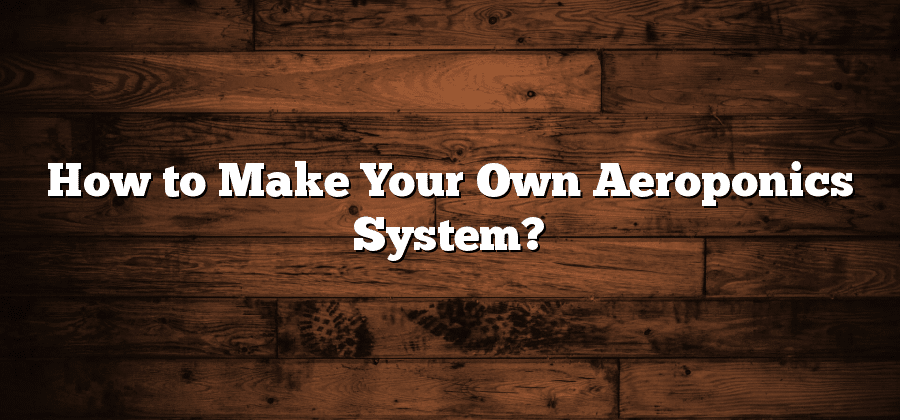Understanding Aeroponics and Its Benefits
Aeroponics is an advanced cultivation method that is gaining popularity in the field of agriculture. This technique involves growing plants in an air or mist environment, with their roots suspended in the air. Unlike traditional soil-based cultivation methods, aeroponics provides several benefits for plant growth.
One of the main advantages of aeroponics is its efficient use of water. Since the plants’ roots are exposed to a fine mist, they are able to absorb moisture and nutrients more effectively. This not only reduces water consumption compared to traditional irrigation methods but also minimizes the risk of over or under-watering, leading to healthier plants. Additionally, aeroponics eliminates the need for soil, which can be a breeding ground for pests and diseases. This results in a significant reduction in the use of pesticides and herbicides, making aeroponics a more environmentally-friendly and sustainable approach to farming.
Selecting the Right Components for Your Aeroponics System
When it comes to selecting the right components for your aeroponics system, there are several important factors to consider. Firstly, you need to choose a high-quality reservoir that can hold an adequate amount of nutrient solution for your plants. Look for a durable material such as food-grade plastic or stainless steel, as this will ensure longevity and prevent any contamination of the nutrient solution.
Next, you will need to carefully choose the right type of spray nozzles for your aeroponics system. These nozzles are responsible for delivering a fine mist of nutrient solution to the roots of your plants. It is crucial to select ones that are specifically designed for aeroponics and can produce a consistent and even spray pattern. Additionally, consider the flow rate and adjustability of the nozzles to meet the specific needs of your plants. Taking the time to research and invest in the right components will help you create a well-functioning aeroponics system that has the potential to yield exceptional results.
Designing the Layout and Structure of Your Aeroponics System
Creating an efficient layout and structure for your aeroponics system is crucial to its success. The first step in this process is to determine the available space and the desired capacity of your system. Consider factors such as the type and number of plants you will be growing, as well as the resources needed, such as water and electricity. It is important to ensure that the layout allows for easy access to all components for maintenance and harvesting.
Next, you will need to arrange the components of your aeroponics system in a logical and organized manner. Start by placing the reservoir, which holds the nutrient solution, in a central location for ease of access. Then, position the pump near the reservoir to ensure efficient circulation of the solution. From there, carefully plan the placement of the misting nozzles and ensure they are evenly distributed to provide adequate coverage to all the plants. Finally, consider the placement of the support structures, such as trellises or racks, to accommodate the growth of your plants as they reach their full potential.
A well-thought-out layout and structure for your aeroponics system will not only optimize space utilization but also facilitate better plant growth and maintenance. By carefully considering the available space and the components needed, you can design an efficient system that will ultimately contribute to the success of your aeroponic gardening endeavors.
Choosing the Ideal Growing Medium for Aeroponics
When it comes to aeroponics, the choice of growing medium plays a critical role in the success of your system. Unlike traditional soil-based gardening or even hydroponics, aeroponics relies on a mist of nutrient-rich water to provide the necessary nutrients to the plants’ roots. Therefore, it is important to choose a growing medium that maximizes nutrient absorption while also offering support to the plants.
One popular option for growing medium in aeroponics systems is a mixture of coco coir and perlite. Coco coir is derived from the husk of coconuts and has excellent water retention properties. When combined with perlite, a lightweight volcanic rock that provides aeration and drainage, this mixture creates an ideal environment for root development and nutrient uptake. Another option is the use of a high-quality clay aggregate, such as expanded clay pellets. These lightweight and porous clay balls provide ample oxygenation to the roots while also retaining moisture and nutrients. Ultimately, the choice of growing medium will depend on the plant species grown, system setup, and personal preferences.
Installing the Necessary Equipment in Your Aeroponics System
To ensure the success of your aeroponics system, it is crucial to install the necessary equipment properly. The first step is to carefully select a high-quality pump that can provide a steady and reliable flow of nutrient solution to your plants. Look for a pump that has a sufficient capacity to meet the needs of your system and is durable enough to withstand continuous operation. Once you have chosen the ideal pump, it is important to install it correctly, ensuring that it is securely fastened and positioned at the appropriate height to maintain optimal pressure and flow.
In addition to the pump, another crucial component of your aeroponics system is the misting nozzles. These nozzles are responsible for creating a fine mist of nutrient solution that will be delivered to the plant roots. It is essential to select high-quality nozzles that are specifically designed for aeroponics systems. The size and type of nozzle you choose will depend on factors such as the size of your system and the specific needs of your plants. Proper installation of the nozzles involves positioning them at an optimal distance from the plant roots and ensuring that they are securely attached to prevent leakage.






